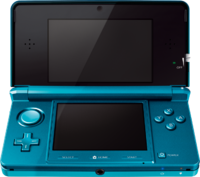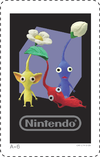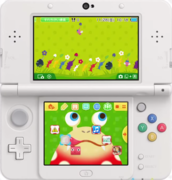Nintendo 3DS
|
This article or section is in need of more images. Particularly: |
The Nintendo 3DS is a handheld console developed by Nintendo, released on February 26, 2011 in Japan, March 27, 2011 in North America, March 25, 2011 in Europe, and March 31, 2011in Australia. It is the primary successor to the Nintedo DSi. It was first revealed at E3 2010. While the design of both systems are similar, the 3DS now features a control-stick style button known as the Circle Pad.
The main gimmick behind the 3DS, like the name suggests, is its ability to display images in stereoscopic 3D without the use of 3D glasses. The 3D feature would allow games to add more depth and style to the game. For example, in Super Mario 3D Land, certain 1-Up mushrooms are actually just cardboard cutouts. The only easy way to tell the difference between the fakes and the real mushrooms is to turn on the 3D feature. While most games do not stress the 3D feature, it is certainly available for use.
Like the DSi, Nintendo eventually released the 3DS XL, on July 28, 2012 in Japan, August 19, 2012 in North America, July 28, 2012 in Europe, and August 23, 2012 in Australia. The same aspects of the system return, except now the 3DS has been scaled up about 90% to allow those with bigger hands a more comfortable experience. Nintendo also released a 2DS, a version of the 3DS that is unable to use the 3D feature but still plays its games. The system is no longer foldable, and less portable. This was created likely so that kids could play the games without having the 3D effect harm their eyes.
The 3DS is backwards compatible, meaning games for the DS and DSi are still playable on the 3DS. Toggling the 3D feature in a DS game, however, has no effect. The Circle Pad also cannot be used in DS games.
In Japan and Australia, a successor to the 3DS was announced, in the form of the New Nintendo 3DS.
Pikmin content
Bundled with the 3DS is a pack of AR Cards, one of which features a red, yellow, and blue Pikmin. These cards can be used in the built-in app AR Games, and in various software that supports AR Cards, like Tomadachi Life. This Pikmin AR Card can be used in the game "Star Photos," where they come to life. The player is able to take photos with them and the Question Mark Cube. The Pikmin have 5 different poses:
- The red Pikmin is laying down, while the others are standing up.
- The red and yellow Pikmin are running, and the blue Pikmin has tripped.
- The 3 Pikmin are carrying a blue 1-Pellet.
- The yellow and red Pikmin are planted, and the blue Pikmin stares at the sprouts.
- All 3 Pikmin join hands.
When transfering downloadable content from DSi to 3DS, or 3DS to 3DS XL, various types of Pikmin are seen "carrying" the data over.
Pikmin 3 was originally made for Game Boy Advance, and later Nintendo 3DS, but Shigeru Miyamoto wasn't happy that either of these consoles allowed for the type of game he wanted to produce. Eventually, he settled on the Wii U.[1]
Currently, there are 2 Pikmin related 3DS themes available on the 3DS Theme Shop. One is called "Working Together", and features a picture with the various Pikmin types on top. On the bottom, there is an animated image of various Pikmin working, being followed by a Red Bulborb. The second is called "Hungry Bulborb." This theme features many cartoon styled Pikmin on the top screen walking. On the bottom screen is a cartoon-styled Bulborb which will move its eyes upon moving the cursor on the bottom screen.
New Nintendo 3DS
The New Nintendo 3DS is a semi-successor to the 3DS that has only been released in Japan on October 11, 2014, and November 21, 2014 in Australia. The system is essentially a more powerful 3DS. The most notable difference is the addition of a smaller circle pad near the A B X Y buttons, referred to as the C-Stick. 2 shoulder buttons, ZL and ZR, were also added, making it basically a 3DS with a built in Circle Pad Pro, an accessory for the 3DS adding a second Circle Pad. The C-Stick and Shoulder buttons are able to be used in New 3DS titles as well as 3DS titles that support it.
The hardware of the New Nintendo 3DS is significantly better than the 3DS, apparently being close to that of the Wii's. As such, it is capable to play many more games, most notably, Xenoblade Chronicles, a video game with a very large open world. Considering it has the power close to the Wii's, a Pikmin game could in theory be possible on this system. Other minor adjustments are included, such as the 3D feature now working from an angle. The systems are overall lighter and larger than their counterparts. Similar to the 3DS, a New 3DS XL is also available.
The New Nintendo 3DS is backwards compatible with 3DS titles as well as DS titles. However, certain games that utilize the system's CPU, like the mentioned Xenoblade Chronicles, can only be played on the system, and not its predecessor. Like the 3DS, the New 3DS and New 3DS XL can have their cover plates exchanged. The new system's game card slot is instead on the bottom of the system, along with the stylus holder. Other minor changes are present, like the A B X Y buttons being colored to match the theme of the Super Famicom, improved battery life, and Amiibo compatibility. Data can be transferred over from the 3DS to the New 3DS as well.
Trivia
- The AR Card for Pikmin has a pose where 3 Pikmin carry a 1-Pellet, a feat not possible without winged Pikmin.




